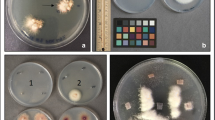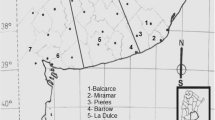Abstract
Research was undertaken to identify Fusarium spp. associated with an endemic wild rice (Oryza australiensis) community in northern Australia and determine the incidence of species reported as pathogens of tropical grain crops. A total of 92 isolates representing six Fusarium species were recovered from O. australiensis. Taxa were delimited based on morphological and phylogenetic (TEF-1α sequence) characters and identified as F. incarnatum-equiseti species complex (55 %), Gibberella fujikuroi species complex (GFSC, 27 %), F. longipes (14 %) and an unidentified Fusarium sp. (3 %). F. sacchari was dominant in the GFSC, a reported mycotoxin (beauvericin, fumonisin) producer and pathogen of sugarcane and sorghum. No isolates were identified as F. fujikuroi, the cause of Bakanae disease of rice in south-east Asia and other rice growing regions. Morphological, phylogenetic and phenetic (AFLP) analyses were in accordance, differentiating all F. sacchari isolates from other Fusarium taxa. The ratio of F. sacchari mating types (15 MAT-1:9 MAT-2) in the O. australiensis population was not significantly different from that expected under random mating (1:1). The effective population number (Ne) based on mating type (Ne(mt)) was 94 % of the count (total population). In contrast, that based on female-fertile isolates (Ne(f)) was 15 %, implying low frequencies of sexual reproduction among F. sacchari isolates. Pathogenicities of three F. sacchari genotypes were assessed against O. australiensis and commercial cultivars of rice, sorghum and maize. All F. sacchari isolates significantly (P < 0.001) reduced emergence of O. australiensis and rice, but not sorghum or maize. Isolation frequencies of all genotypes from sorghum and maize and one isolate from O. australiensis were significantly (P < 0.001) greater than the controls. There were no significant differences in F. sacchari re-isolation among rice treatments. Thus, F. sacchari is presumed to be a pre-emergent ‘damping off’ pathogen, endophyte or weak parasite of O. australiensis and rice and a root and crown pathogen of sorghum and maize.




Similar content being viewed by others
References
Amatulli, M. T., Spadaro, D., Gullino, M. L., & Garibaldi, A. (2010). Molecular identification of Fusarium spp. associated with Bakanae disease of rice in Italy and assessment of their pathogenicity. Plant Pathology, 59, 839–844.
Balmas, V., Corda, P., Marcello, A., & Bottalico, A. (2000). Fusarium nygamai associated with Fusarium foot rot of rice in Sardinia. Plant Disease, 84, 807.
Bentley, A. R., Petrovic, T., Griffiths, S. P., Burgess, L. W., & Summerell, B. A. (2007). Crop pathogens and other Fusarium species associated with Austrostipa aristiglumis. Australasian Plant Pathology, 36, 434–438.
Carter, L. A., Leslie, J. F., & Webster, R. K. (2008). Population structure of Fusarium fujikuroi from California rice and water grass. Phytopathology, 98, 992–998.
Chander, J., Singla, N., Gulati, N., & Sood, S. (2011). Fusarium sacchari: a cause of exogenous fungal endophthalmitis: first case report and review of literature. Mycopathologia, 171, 431–434.
Claflin, L. E., & Giorda, L. M. (2002). Stalk rots of sorghum. In J. F. Leslie (Ed.), Sorghum and millets diseases (pp. 185–190). Ames: Iowa State University Press.
Egan, B. T., Magarey, R. C., & Croft, B. J. (1997). Sugarcane. In R. J. Hillocks & J. M. Walker (Eds.), Soilborne diseases of tropical crops (pp. 277–302). Oxon: CAB International.
Gomez, D. R., Evans, K. J., Harvey, P. R., Baker, J., Barton, J., Jourdan, M., et al. (2006). Genetic diversity in the blackberry rust pathogen, Phragmidium violaceum, in Europe and Australasia as revealed by analysis of SAMPL. Mycolgical Research, 110, 423–430.
Hall, T. A. (1999). BioEdit: a user friendly biological sequence alignment editor and analysis program for Windows 95/98/NT. Nucleic Acids Symposium Series, 41, 95–98.
Harvey, P. R., Butterworth, P. J., Hawke, B. G., & Pankhurst, C. E. (2001a). Genetic and pathogenic variation among cereal, medic and sub-clover isolates of Pythium irregulare. Mycolgical Research, 105, 85–93.
Harvey, P. R., Langridge, P., & Marshall, D. R. (2001b). Genetic drift and host-mediated selection cause genetic differentiation among Gaeumannomyces graminis populations infecting cereals in southern Australia. Mycological Research, 105, 927–935.
Harvey, P. R., Warren, R. A., & Wakelin, S. (2008). The Pythium-Fusarium root disease complex - an emerging constraint to irrigated maize in southern New South Wales. Australian Journal of Experimental Agriculture, 48, 367–374.
Henry, R. J., Rice, N., Waters, D. L. E., Kasem, S., Ishikawa, R., Hao, Y., et al. (2010). Australian Oryza: utility and conservation. Rice, 3, 235–241.
Hsuan, H. M., Salleh, B., & Zakaria, L. (2011). Molecular identification of Fusarium species in Gibberella fujikuroi species complex from rice, sugarcane and maize from Peninsular Malaysia. International Journal of Molecular Sciences, 12, 6722–6732.
Kvas, M., Marasas, W. F. O., Wingfield, B. D., Wingfield, M. J., & Steenkamp, E. T. (2009). Diversity and evolution of Fusarium species in the Gibberella fujikuroi complex. Fungal Diversity, 34, 1–21.
Laurence, M. H., Summerell, B. A., Burgess, L. W., & Liew, E. C. Y. (2011). Fusarium burgessii sp. nov. representing a novel lineage in the genus Fusarium. Fungal Diversity, 49, 101–112.
Leslie, J. F. (1995). Gibberella fujikuroi: available populations and variable traits. Canadian Journal of Botany, 73(Suppl. 1), S282–S291.
Leslie, J. F., & Klein, K. K. (1996). Female fertility and mating type effects on effective population size and evolution in filamentous fungi. Genetics, 144, 557–567.
Leslie, J. F., & Summerell, B. A. (2006). The Fusarium laboratory manual. Ames: Blackwell Publishing Professional.
Leslie, J. F., Summerell, B. A., Bullock, S., & Doe, F. J. (2005). Description of Gibberella sacchari and neotypification of its anamorph Fusarium sacchari. Mycologia, 97, 718–724.
Moretti, A., Mule, G., Ritieni, A., & Logrieco, A. (2007). Further data on the production of beauvericin, enniatins and fusaproliferin and toxicity to Artemia salina by Fusarium species of Gibberella fujikuroi species complex. International Journal of Food Microbilogy, 118, 158–163.
Nauer, E. M., Roistacher, C. N., & Labanauskas, C. K. (1968). Growing citrus in modified U.C. potting mixtures. California Citrograph, 53, 456–461.
Nei, M., & Li, W. H. (1979). Mathematical model for studying genetic variation in terms of restriction endonucleases. Proceedings of the National Academy of Sciences of the United States of America, 76, 5269–5273.
O’Donnell, K., Cigelnik, E., & Nirenberg, H. I. (1998). Molecular systematics and phylogeography of the Gibberella fujikuroi species complex. Mycologia, 90, 465–493.
O’Donnell, K., Nirenberg, H. I., Aoki, T., & Cigelnik, E. (2000). A multigene phylogeny of the Gibberella fujikuroi species complex: detection of additional phylogenetically distinct species. Mycoscience, 41, 61–78.
O’Donnell, K., Sutton, D. A., Rinaldi, M. G., Gueidan, C., Crous, P. W., & Geiser, D. M. (2009). Novel multilocus sequence typing scheme reveals high genetic diversity of human pathogenic members of the Fusarium incarnatum-F. equiseti and F. chlamydosporum species complexes within the United States. Journal of Clinical Microbiology, 48, 3708–3718.
Oren, L., Ezrati, S., Cohen, D., & Sharon, A. (2003). Early events in the Fusarium verticillioides-maize interaction characterized by using a green fluorescent protein-expressing transgenic isolate. Applied and Environmental Microbiology, 69, 1695–1701.
Petrovic, T., Walsh, J. L., Burgess, L. W., & Summerell, B. A. (2009). Fusarium speces associated with stalk rot of grain sorghum in the northern grain belt of eastern Australia. Australasian Plant Pathology, 38, 373–379.
Ploetz, R. C. (2007). Diseases of tropical perennial crops: challenging problems in diverse environments. Plant Disease, 91, 644–663.
Proctor, R. H., McCormick, S. P., Alexander, N. J., & Desjardins, A. E. (2009). Evidence that a secondary metabolic biosynthetic gene cluster has grown by gene relocation during evolution of the filamentous fungus Fusarium. Molecular Microbiology, 74, 1128–1142.
Rodriguez, R. J., White, J. F. J., Arnold, A. E., & Redman, R. S. (2009). Fungal endophytes: diversity and functional roles. New Phytologist, 182, 314–330.
Sharma, R., Thakur, R. P., Senthilvel, S., Nayak, S., Reddy, S. V., Panduranga Rao, V., et al. (2011). Identification and characterization of toxigenic Fusaria associated with sorghum grain mold complex in India. Mycopathologia, 171, 223–230.
Summerell, B. A., Leslie, J. F., Liew, E. C. Y., Laurence, M. H., Bullock, S., Petrovic, T., et al. (2011). Fusarium species associated with plants in Australia. Fungal Diversity, 46, 1–27.
Swofford, D. L. (1998). PAUP*. Phylogenetic analysis using parsimony (*and other methods). Sunderland: Sinauer Associates.
Tarnowski, T. L., Perez-Martinez, J. M., & Ploetz, R. C. (2010). Fuzzy pedicel: a new postharvest disease of banana. Plant Disease, 94, 621–627.
Thompson, J. D., Higgins, D. G., & Gibson, T. J. (1994). CLUSTAL W: improving the sensitivity of progressive multiple sequence alignment through sequence weighting, position specific gap penalties and weight matrix choice. Nucleic Acids Research, 22, 4673–4680.
Trimboli, D. S., & Burgess, L. W. (1983). Reproduction of Fusarium moniliforme basal stalk rot and root rot of grain sorghum in the greenhouse. Plant Disease, 67, 891–894.
Vaughan, D. A., Lu, B.-R., & Tomooka, N. (2008). The evolving story of rice evolution. Plant Science, 174, 394–408.
Viswanathan, R., Poongothai, M., & Malathi, P. (2011). Pathogenic and molecular confirmation of Fusarium sacchari causing wilt in sugarcane. Sugar Tech, 13, 68–76.
Walsh, J. L., Laurence, M. H., Liew, E. C. Y., Sangalang, A. E., Burgess, L. W., Summerell, B. A., et al. (2010). Fusarium: two endophytic novel species from tropical grasses of northern Australia. Fungal Diversity, 44, 149–159.
Wang, B., Priest, M. J., Davidson, A., Brubaker, C. L., Woods, M. J., & Burdon, J. J. (2007). Fungal endophytes of native Gossypium species in Australia. Mycological Research, 111, 347–354.
Wang, B., Brubaker, C. L., Tate, W., Woods, M. J., & Burdon, J. J. (2008). Evolution of virulence in Fusarium oxysporum f.sp. vasinfectum using serial passage assays through susceptible cotton. Phytopathology, 98, 296–303.
Wang, B., Brubaker, C. L., Summerell, B. A., Thrall, P. H., & Burdon, J. J. (2010). Local origin of two vegetative compatibility groups of Fusarium oxysporum f. sp. vasinfecum in Australia. Evolutionary Application, 3, 505–524.
Wulff, E. G., Sorensen, J. L., Lubeck, M., Nielsen, K. F., Thrane, U., & Torp, J. (2010). Fusarium spp. associated with Bakanae: ecology, genetic diversity, pathogenicity and toxigenicity. Environmental Microbiology, 12, 649–657.
Yap, I. V., & Nelson, R. J. (1996). WinBoot: A program for performing bootstrap analysis of binary data to determine the confidence limits of UPGMA-based dendrograms. Los Banos: International Rice Research Institute.
Acknowledgments
This research was supported by CSIRO Sustainable Agriculture National Research Flagship. We thank Dr. Matthew Laurence (Royal Botanic Gardens, Sydney, New South Wales) for providing the F. sacchari reference strains and Dr. Sally Norton (Australian Tropical Crops and Forages Collection, Queensland Department of Primary Industries) and Dr Peter Snell (Yanco Agricultural Institute, New South Wales) for providing seed for pathogenicity tests.
Author information
Authors and Affiliations
Corresponding author
Rights and permissions
About this article
Cite this article
Petrovic, T., Burgess, L.W., Cowie, I. et al. Diversity and fertility of Fusarium sacchari from wild rice (Oryza australiensis) in Northern Australia, and pathogenicity tests with wild rice, rice, sorghum and maize. Eur J Plant Pathol 136, 773–788 (2013). https://doi.org/10.1007/s10658-013-0206-7
Accepted:
Published:
Issue Date:
DOI: https://doi.org/10.1007/s10658-013-0206-7




